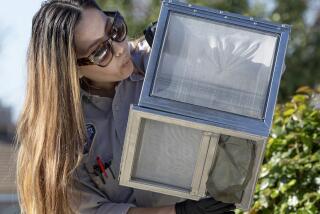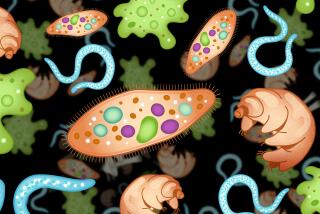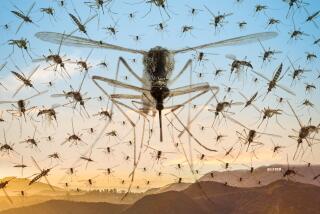Mosquitoes spread deadly diseases, and public health experts hope to fight back with this new emoji
- Share via
Mosquitoes are more than a spoiler of backyard barbecues. They threaten more than half the world’s population with their disease-spreading bites. In fact, mosquitoes are deadlier — by far — than sharks and snakes.
They are the incubator and chief disseminator of malaria, dengue and yellow fevers, as well as newer scourges like the West Nile and Zika viruses. Their numbers explode with floods, hurricanes and climate change, allowing them to outnumber every animal on Earth during their peak breeding season. Public-health officials fret about them 24/7.
So how is it that this fearsome creature has no emoji?
Check your phone: You’ve got a honey bee, a caterpillar, a spider, an ant and a ladybug, not to mention all manner of mammals, birds and sea creatures.
But no mosquito.
That oversight cries out for a fix, according to a pair of public-health specialists. That’s why they have petitioned a group called the Unicode Consortium to include a female mosquito — the only kind that bite humans and spread disease — in the next batch of emojis that will be available on smart phones next year.
The mosquito is one of 67 finalists. It’s up against a llama, a tooth and a lab coat, among other contenders.
If chosen, the emoji mosquito could begin spreading over our digital networks just as real mosquitoes set out from their watery habitats across the tropics and northern hemisphere in search of human blood to nourish their eggs — next summer.
Those blood meals could expose a mosquito mother to a disease-causing virus. If so, the virus is incubated in the insect’s midgut and travels to her salivary glands, ready to be expelled into a new human host when she takes another next blood meal.
In their appeal to the Unicode Consortium, Marla Shaivitz, a communications specialist at the Johns Hopkins University’s Bloomberg School of Public Health, and Jeff Chertack, a malaria expert at the Bill & Melinda Gates Foundation, argue that a mosquito emoji “would likely be used by the hundreds of millions of people affected by mosquitoes every year, as well as the scientific and health community to explain their work.”
How? The mosquito emoji could alert communities that eradication efforts are underway nearby, or that disease-prevention tools — such as mosquito nets or repellent — are being distributed. Public health campaigns urging people to clean up standing water could use it, as could those warning of new or resurgent viral threats, Shaivitz and Chertack write.
Sure, you could use it to ask someone to stop pestering you. But after a storm, public health officials could also pair the mosquito emoji with the rain cloud to encourage people outside to cover up and apply some insecticide, the two contend.
“The expected use of a mosquito emoji is extremely high,” wrote the campaign’s instigators. Compared with, say, tweets related to beetles (an insect that rates an emoji), an average day on Twitter brings 15,000 more mosquito-related tweets, they noted.
When mosquito-borne dengue fever outbreaks have threatened Key West, Fla., and parts of Texas, community engagement — especially with children — was used with great success, said Dr. Amesh Adalja, an infectious disease expert at Johns Hopkins’ Center for Health Security.
With the world threatened by so many mosquito-borne diseases, an icon that speaks to children as loudly as it does to adults “could help those efforts,” Adalja said.
Dr. Georges Benjamin, executive director of the American Public Health Assn., is another fan.
“We live in a very visual world, a world in which one icon can convey complex thoughts,” Benjamin said. “Using images like this that are easily recognizable to remind people to protect themselves, to learn things, to seek out other information: That makes a lot of sense in today’s environment.”
Benjamin cited “Mr. Yuk,” the grimacing green icon created to warn of household products that would be poisonous to ingest, as a tribute to the power of an image to convey public-health information quickly and effectively.
“It’s not silly at all,” he said of the emoji initiative.
Dr. Robert Amler, dean of New York Medical College’s School of Health Sciences and Practice, called the proposed mosquito emoji “a terrific idea.”
A longtime public health officer, Amler said the emoji puts the power of digital media to work in fighting the illnesses these pests spread.
“I’m not an art critic,” he added, “but I think the design work is excellent.”
Derek Cummings, a University of Florida expert on mosquito-borne diseases, thinks the insect that spreads viruses on six of seven continents has long since proved it is worthy of an emoji.
After all, he said, this bug has evolved alongside viruses and human populations to play a remarkably potent role in our lives.
In a world that has an emoji of a ladybug and a butterfly, he asks, “why not mosquitoes?”
Twitter: @LATMelissaHealy
MORE IN SCIENCE
Plant-eating dinosaurs may have dined on crustaceans on special occasions, study says
Domestic violence homicide rate drops with stricter gun law, study finds
Pediatricians may view tattoos, piercings as red flags. They should discuss it instead, report says







